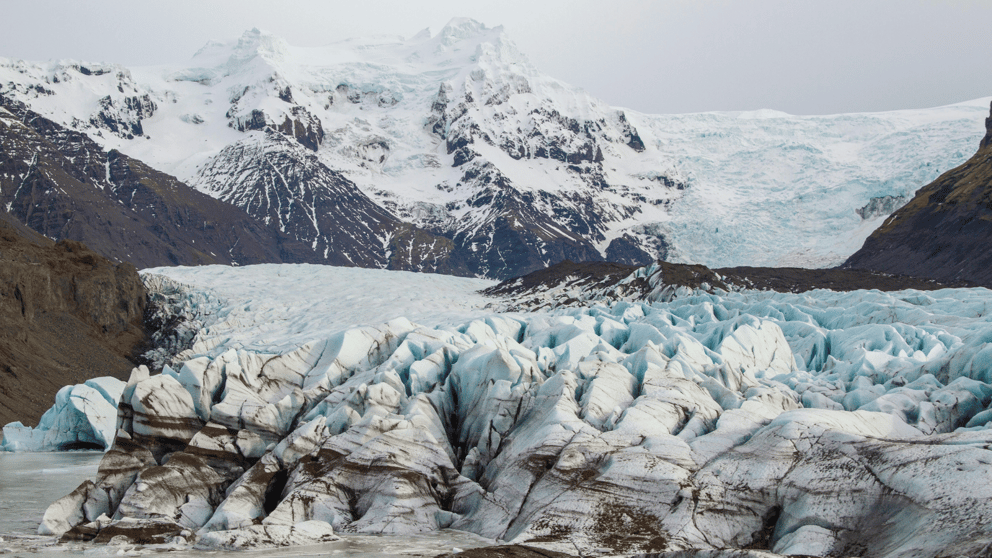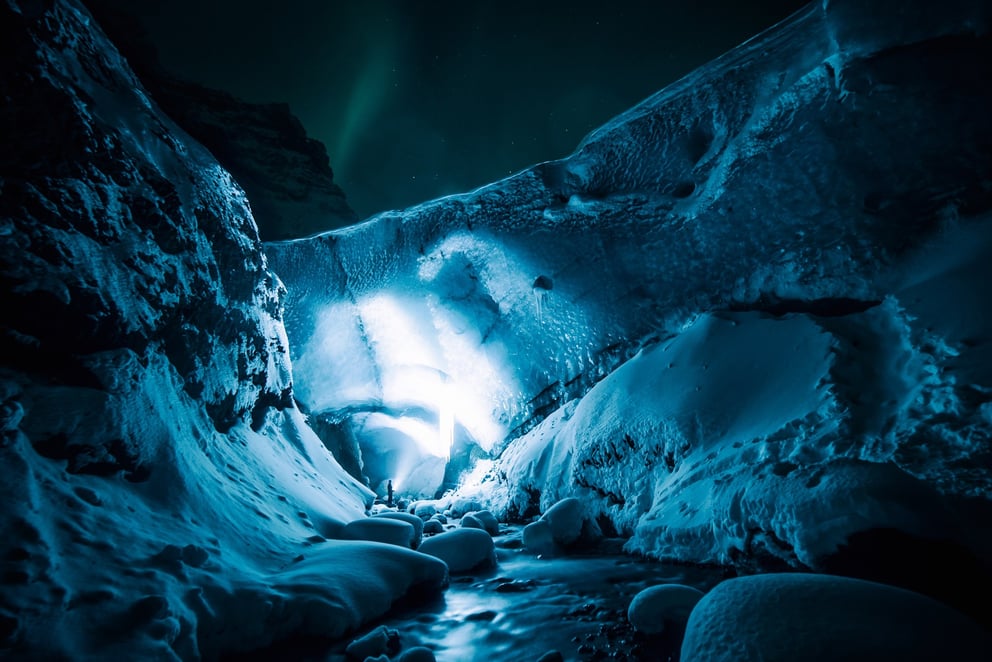The Ultimate Guide to Iceland's Glaciers
Iceland has a unique landscape that is unlike anywhere else in the world and is one of the main reasons that so many people take a vacation in the country. Covering roughly 11% of the country, there aren’t many other places around the world where you can experience magnificent ice glaciers as you can in Iceland.
Depending on the time of year, Icelanders and visitors are blessed with the opportunity to hike and climb up some magnificent ice glaciers. But if you’ve never been to Iceland before, then it can be confusing knowing how it all works and where you can find these ice glaciers. We have put together an ultimate guide to glaciers in Iceland to help you navigate this and find the best tours to suit your needs.

What Are Glaciers and Are They Safe?
A glacier is quite simply a body of ice that exists and has built up over the years, often centuries, to form large icy structures. It often occurs when more snow is falling than melting, so it becomes compacted and freezes, turning into an icy glacier. Glaciers can also move due to the force of gravity or liquid water running underneath, so they are constantly changing structures and so much more than just a frozen lake.

Most Famous Glaciers in Iceland
Reading up before you book your tour? Here are just a few of Iceland’s most famous glaciers.
Vatnajökull
Located in the Southeast of Iceland, Vatnajökull is the largest glacier in Iceland, and in fact, the largest one in Europe. Its area spans around 8,300 square kilometers, or 3,200 square miles, which is just shy of 8% of the entire land mass of Iceland. Its size means that parts of it, often outlet glaciers or tongues, are visited as part of tours around Iceland.
Vatnajokull National Park encompasses a mere portion of the glacier, which is famous for great hiking opportunities, glacier hiking, boat tours on Jokulsarlon Glacier Lagoon, and even exploring ice caves on tours.
Langjökull
Located in western Iceland, Langjökull translates literally in English to “long glacier” for its long, thin shape. Langjökull is the second largest glacier in Iceland and is known to be much calmer in a volcanic sense than other areas of the country. With just a handful of eruptions in the past 10,000 years, exploring here is known to be very safe from volcanic activity.
This is also the closest glacier to Reykjavik, though still around 2.5 hours by car, so you are more likely to head here on day trips from the capital due to its proximity. It is also just beyond Þingvellir National Park, and meltwater from Langjökull feeds iconic attractions on the Golden Circle, such as the powerful Gullfoss Waterfall. Glacier hiking, ice climbing, and snowmobiling tours are all offered on this glacier and its outlets.
Eyjafjallajökull
While the other glaciers above are well-known for being larger and having more outlet glaciers and tongues, as well as lagoons, to explore, Eyjafjallajökull is famous for a more dramatic reason. Eyjafjallajökull glacier sits over the volcano with the same name, which became an almost household name back in 2010 (if you could pronounce it!).
You may know the glacier as E15, shortened originally by a German reporter as news outlets struggled to pronounce the Icelandic word following the ash cloud that settled over Europe in 2010. We’re sure you’ll remember the hundreds of flights grounded across Western Europe as a result of the ash in the atmosphere, as well as the evacuation of around 500 local people.

Can I Walk on Glaciers in Iceland?
Glaciers are only safe to walk or climb if you have a guide, as there can be hidden cracks and crevices that you don’t spot. There are a number of glaciers or glacier tongues that are close to the capital, making it convenient to book single-day or multi-day tours.
Do I Need Any Equipment?
You don’t need to bring any specialist equipment to go hiking along the glaciers, as this should be provided by your tour guide. They will provide you with things like helmets, harnesses, and crampons to make sure that you are safe on your ice tour. Your guide will also know the route, so there may also be other pieces of equipment they provide you with at the start of the hike, but this will all be explained to you.
You should, of course, make sure that you wear warm clothes for hiking glaciers, consider thermals rather than bulky clothes, and wear waterproof clothing in case you get wet. Although it is likely to be cold, you should also bring sunglasses and sunscreen with you as the glare from the sun reflects on the ice, and it can be quite bright. One of the most important items you must invest in is some sturdy hiking boots for good grip underfoot.
When Is the Best Time of Year For Seeing Iceland’s Glaciers?
It is much easier to tour the glaciers in Iceland during the summer months as the weather is a lot better and there are long hours of daylight. However, you will not see the glaciers in their full glory unless you travel during the winter.
There are, of course, advantages and disadvantages to both, but you can go on glacier hiking tours and expeditions all year round. We have put together a list of some of the main advantages and disadvantages of traveling at different times of the year.
Advantages of Glaciers in the Summer
- Long hours of sunlight and much greater views of the region
- Better weather conditions and warmer average temperatures
- Trips are less likely to be cancelled due to adverse weather conditions
- Easier to hike and climb in better conditions
Advantages of Glaciers in the Winter
- New ice freezes and forms over the glacier, so it looks amazing
- Striking electric blue glaciers form in winter as opposed to melted glaciers in summer
- More likely to see spectacular ice caves during winter

Types of Glacier Tours in Iceland
There are many different types of glacier tours that you can embark on during your trip to Iceland. Depending on who you are traveling with and how much physical activity you want to undertake on your holiday, there are different ways to see the glacier that will suit different people. Some of the most popular types of glacier tours include;
- Glacier Hiking & Climbing - this is one of the most popular activities, but also involves the most physical activity. You will hike and climb up glaciers using ice axes and crampons.
- Glacier Ice Caving - this is an activity for the winter months, but is extremely popular as the ice caves are unlike anything you are likely to see anywhere else.
- Glacier Snowmobiling - this is a great way to get some adrenaline in your trip and see the glacial regions, but you won’t get up close to the glaciers.
- Glacial Lagoon Boat Tours - if you have younger children, then why not opt for a boat tour that is exciting but not too strenuous?
- Glacier Super Jeep Tours - another great way to see the glaciers, if you aren’t fond of hiking or with children, is to get up close and personal with a super jeep tour.
Where Can I Go On A Glacier Tour?
There are a number of different places that you can go on a glacier tour during your trip to Iceland. There are many different glaciers and places to choose from, and it can be a little confusing if you are not sure about the difference. However, each glacier has its own charm and individuality, so there isn’t any great way to set them apart. We have put together a list of some of the most popular glaciers in Iceland.
- Sólheimajökull - close to Reykjavik, great for beginners
- Skaftafell - 4 hours from Reykjavik, a national park with much more to see and do
- Snæfellsjökull - a more challenging climb, 2 hours from Reykjavik
- Vatnajökull - challenging tour, lesser known and less crowded
Map of Iceland’s Glaciers
Find a map below of all of the glaciers in Iceland mentioned in this blog, plus some extras!
So there you have it, a host of ice giants on display all over Iceland! If you’re more keen on driving yourself to witness these glaciers, then our range of Iceland rental cars is the perfect choice. Book today to avoid disappointment!

